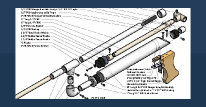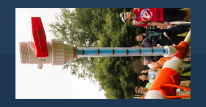Can't say I'm entirely surprised. I have yet to leave mine in a cold environment over time and then used it. I usually try not to nerf in the cold either because I just die and have a general intolerance for cold. You actually could probably swap out the latex tubing for an extension spring if you found one to be the correct size, although I kind of doubt it and you may have to change some dimensions....Stuff about it being cold...
Nothing really takes a substantial amount of force, although I supposed if you dropped it on pavement from a considerable distance on the barrel spacers it may break, I don't know. I haven't tried it and most time spent is on grass when nerfing so I wouldn't worry about it too much.Wow well done. It's a really glorious blaster. How well do the 3d printed components holdup to bending forces. The 8 shaped pieces, they seem like they normally wouldn't encounter strong forces but would you think they would break if you dropped it? How long does it take you to actually make one? It seems like easy blaster to assemble once you have all the parts.
Yes. Any of the printed pieces could be swapped out for any type of plastic or wood you want. Or metal if you're into that.I think Ryan and I were discussing this elsewhere, but the blaster is designed to not need 3d printed parts (or, the 3d printed parts are designed to be replicated with normal woodworking machines, like routers and saws; which means you could use just about any material instead of 3d printed stuff if you want). Most of the 3d printed parts don't need to be 3d printed, but in these blasters most of the parts look like they're both thick enough and not in high stress areas to make bending an issue (or dropping).
=================================
Mostly finished up the final design for this blaster. I ran into the problem everyone was worried about, which was a bunch of torque on the priming handle. The difference from this and the last blaster, is the piece of 1" that is connected to the priming grip was significantly shorter since the whole blaster was shorter overall. To fix this, I extended the slots and 1" piece to add room for another screw through the 1" and priming grip. The torque is now completely gone and it primes very nicely. You can even hold it near the bottom and it still isn't difficult to prime.
I also tried some slightly different barrel spacers. I probably will just use the original ones next time since I have a bunch of them already printed. The only difference it the length of the front tube.
Any of you who frequent #nerfchat have probably already seen the stock, but it's just a printed piece, with another 1/4" sheet mounted on the back. Behind that is a piece of adhesive-backed 1" foam I got from McMaster. It's a little firm, but the curved surface I made for it using the belt sander made it very comfortable. I'll probably sell these as an upgrade and also a standalone item for people to purchase.
Also looking into securing the surgical tubing in a different manner than just tying wtf knots at the end of it. Suggestions are welcome.












































